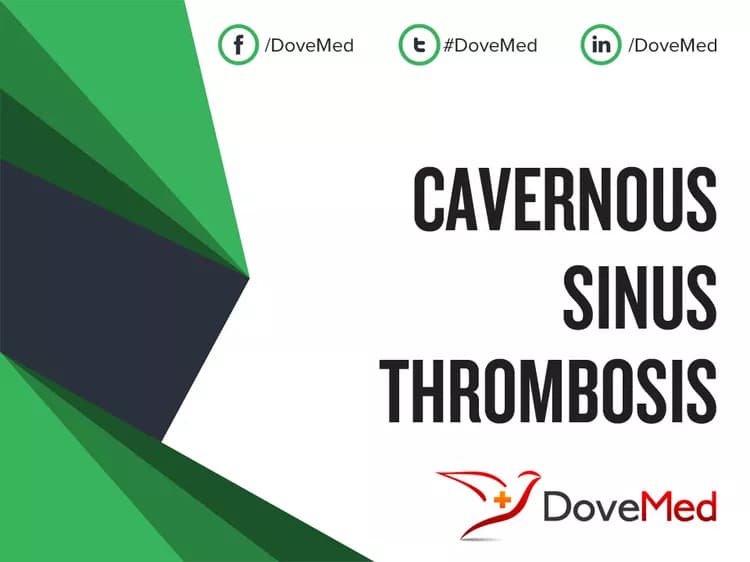What are the other Names for this Condition? (Also known as/Synonyms)
- Cavernous Sinus Thrombophlebitis
- Cerebral Venous Thrombosis of Cavernous Sinus
- Thrombosis-Cavernous Sinus
What is Cavernous Sinus Thrombosis? (Definition/Background Information)
- Cavernous Sinus Thrombosis is a serious, rare, life-threatening condition in which blood clots are formed in one of the structures in the skull, called the cavernous sinus
- The cavernous sinus is a hollow space situated at the bottom of the brain, behind each eye socket). The cavernous sinuses drain venous (deoxygenated) blood from the facial veins
- Bacterial infection from the sinuses, teeth, ears, eyes, nose, or skin of the face is the main cause of Cavernous Sinus Thrombosis. Staphylococcus aureus and Streptococcus are the main organisms responsible for this infection
- The common signs and symptoms of Cavernous Sinus Thrombosis include severe headaches, pain in the eyes, red eyes, involuntary movements of the eyes, and vision abnormalities. The condition may be diagnosed through a complete physical exam, CT scan or MRI scan of the brain
- Intravenous antibiotics are the mainstay of treatment. However, the prognosis of Cavernous Sinus Thrombosis is poor with and the condition is known to have a high mortality rate
Who gets Cavernous Sinus Thrombosis? (Age and Sex Distribution)
- All male and female individuals may be affected by Cavernous Sinus Thrombosis at any age; however, the condition affects women more commonly than men
- Also, young adults and children are more commonly affected than older adults
What are the Risk Factors for Cavernous Sinus Thrombosis? (Predisposing Factors)
The following are the risk factors associated with Cavernous Sinus Thrombosis:
- Gender: Women are more susceptible if they are pregnant or taking contraceptive pills, which puts them at a higher risk of blood clotting
- Age: Often young adults and children are affected more than older adults
- Generally, individuals who have a higher risk of blood clotting are more susceptible to Cavernous Sinus Thrombosis
It is important to note that having a risk factor does not mean that one will get the condition. A risk factor increases ones chances of getting a condition compared to an individual without the risk factors. Some risk factors are more important than others.
Also, not having a risk factor does not mean that an individual will not get the condition. It is always important to discuss the effect of risk factors with your healthcare provider.
What are the Causes of Cavernous Sinus Thrombosis? (Etiology)
Cavernous Sinus Thrombosis may be caused by the following factors:
- The condition is typically caused by the bacterium Staphylococcus aureus and Streptococcus
- Contagious spread of bacterial or fungal infections from the nasal furuncle, or due to sinus infection and dental infection
A blood clot is formed by the body’s immune system to prevent the infection from spreading. The blood clot also increases the pressure inside the brain, which when left undiagnosed or untreated may become fatal.
What are the Signs and Symptoms of Cavernous Sinus Thrombosis?
The common signs and symptoms of Cavernous Sinus Thrombosis include:
- Severe headaches
- Swelling of the white portion of the eyes, bulging pupils
- Severe eye pain, redness of the eyes
- Heaviness and fullness in the eyes
- Double vision
- Uncontrollable and involuntary movement of the eyes
- Drooping of the eyelids
- High fever
- Confusion
- Body weakness
- Speech problems
How is Cavernous Sinus Thrombosis Diagnosed?
The diagnosis of Cavernous Sinus Thrombosis may involve:
- Complete evaluation of medical history along with a thorough physical examination
- CT scan of the head
- MRI of the brain
- Magnetic resonance venogram
- Sinus X-ray
Many clinical conditions may have similar signs and symptoms. Your healthcare provider may perform additional tests to rule out other clinical conditions to arrive at a definitive diagnosis.
What are the possible Complications of Cavernous Sinus Thrombosis?
A few complications associated with Cavernous Sinus Thrombosis include:
- Seizures
- Permanent loss of vision
- Meningitis: Infection that occurs in the outer protective layers of the brain
- Sepsis: Systemic spread of infection
Death may occur if the condition is left untreated.
How is Cavernous Sinus Thrombosis Treated?
- Intravenous antibiotics are the mainstay of treatment of Cavernous Sinus Thrombosis and this may include nafcillin, cefotaxime, and metronidazole
- The patient may be required to be hospitalized for 3-4 weeks
- In very rare cases, surgery may be performed to drain the infection
How can Cavernous Sinus Thrombosis be Prevented?
- Currently, there is no effective prevention available for Cavernous Sinus Thrombosis
- Early treatment of nasal furuncle and sinus infections may be helpful in preventing the infection spread
What is the Prognosis of Cavernous Sinus Thrombosis? (Outcomes/Resolutions)
- Cavernous sinus thrombosis is a serious and life-threatening condition; even with immediate treatment, the mortality rate remains high
- Individuals who survive may be affected by long-term health conditions caused by damage to the brain such as continuous and frequent headache and seizures
Additional and Relevant Useful Information for Cavernous Sinus Thrombosis:
The following DoveMed website link is a useful resource for additional information:
Related Articles
Test Your Knowledge
Asked by users
Related Centers
Related Specialties
Related Physicians
Related Procedures
Related Resources
Join DoveHubs
and connect with fellow professionals


0 Comments
Please log in to post a comment.